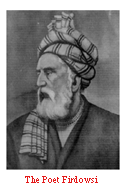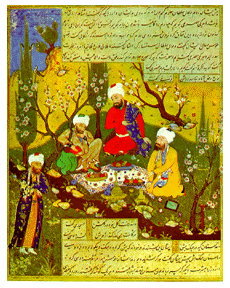
| by |

| by |
Hakim Abu al-Qasim Mansur Firdowsi2 was born about AD 935 to a prosperous and educated dihqan3 family near the town of Tus in Khurasan province. By age thirty, he had developed a good understanding of the past history of Iran. Familiar with the consequences of the Arab conquest of his homeland, he sought to safeguard Iranian heritage against impending assaults by the Turks of Central Asia. Toward this end, he studied the chronicles of Mazandaran, Sistan, Balkh, Bukhara, and Khutan, as well as the oral traditions that had developed over centuries around the ancient culture. These included discussions of immortality, the divine right of kings, knowledge, justice, heroism, vengeance, deceit, and black magic. By age forty, Firdowsi was ready to versify the entire account made available to him by a friend.4
Today, with the exception of a few relics, the historical chronicles that Firdowsi had at his disposal are lost, including most of the church chronicles that he used as the foundation of his epic. Only a meager account is left after the Mongol destruction of the rich civilization of the region known today as Central Asia. While the chronicles and the documents that Firdowsi used have all but vanished, however, his rendition of them in verse remains. By ascertaining the structure of the Shahname, we can identify its focus, search for the motivation for war couched among ample battle scenes composed to amuse the court and gratify the public, and provide a reasonable account of Iranian culture before documented history begins. After all, Firdowsi verifies what we already know from other sources. He gives our scant knowledge of pre-Zoroastrian Central Asia and pre-Islamic Iran direction, perspective, and vitality.
Firdowsi did not invent either his heroes or the events that form the frame of his oeuvre. The tradition he versified harks back, on the one hand, to the efforts of pre-Zoroastrian mu'bads5 who glorified Mazdian saints and, on the other, to the efforts of Parthian and Sassanian monarchs who, to assure the continuity of their own rule, safeguarded Iranian heritage against the incursions of Hellenism and rival religions.
The genesis of Firdowsi's Shahname transcends the tradition whereby Iranian monarchs amplified their deeds to legitimize their right to the kingship of western Iranian lands. It belongs instead to a time when recorded history and genealogies as we know them did not yet exist; oral tradition was the job of the bard and the minstrel. At some point, before the appearance of the Prophet Zoroaster, a controversy arose over the position of religion in relation to the monarchy: Ahura Mazda would not send two deputies to organize His affairs on earth. In response to this development, the court resorted to legitimizing its rule by emphasizing the support its monarchs receive from Ahura Mazda,6 while the mu'bads took refuge in organizing their own chronicles.
In the end, two different accounts developed, each legitimizing a different segment of society as the true guardian of Iran. One had begun as a line of stark genealogies, describing the succession of past kings. This, the official and the historical account, was soon embellished with the story of the quick rise of Cyrus the Great to the rulership of a considerable part of the ancient world and with stories told and retold by veterans of the campaigns of Darius I the Great and Xerxes I. The other tradition, built around the pivotal concepts of martyrdom and kin (vengeance), described the genesis of the sacred land of Iran, its division by injustice, and the measures undertaken to restore the loss. The mu'bads' accounts culminated in a comprehensive compendium on the renovation of the world and the institution of just rulership by the legendary Kaykhusrau. Known as the Chihrdad, this compendium, the most ancient cultural heritage of Iran, forms the core of Firdowsi's epic.7
After the invasion of Alexander the Great, the historical traditions, kept in official archives and summarized on friezes and gold plaques, were used to revive interest in Iran's past glory. Iranian nationalism enabled the Parthians to expel the Greeks and become the masters of Iran. The Sassanians, who succeeded the Parthians, also capitalized on similar traditions in their ascent of the Iranian throne.8 Once in power, they committed those traditions to writing and widely publicized them to strengthen Iranian society against incursions by Buddhism and Christianity.
Oral tradition regarded the world as a battleground upon which the deputies of God waged an unending war against satanic forces. As the historical chroniclers drew on the deeds of past monarchs as proof of divine support for their legitimacy, so the mu'bads drew on the deeds of their saint-figures (Siyavosh and Garshasp, for instance) to stir up public zeal. It was from among this line of heroes, worshiped by the multitude, that Zoroaster emerged, and it was to legitimize Zoroaster's deeds, words, and ideas that the mu'bads organized their chronicles. These chronicles, therefore, provided the mu'bads with an alternate version of the ancient era before the advent of Zoroaster. An era during which exemplary kings ruled who, using their farr (glory), reorganized the affairs of the world and instituted the rule of justice.
The Sassanians held a unique place among Iranian rulers. Since they were a priestly family catapulted into the rulership of western Iran, they were both the makers of recorded history and the custodians of ancient Iranian religious traditions. Under the Sassanians, therefore, the church chronicles gained state sanction and became a part of recorded history. To commemorate the union of church and state, the mu'bads and the court officials cooperated in compiling a single compendium of Iranian history, including the contents of the court archives and the church chronicles. The result was the Khudayname, a compendium that encompassed Iranian lore spanning the formation of Iranian lands, the breaking away of Turan, the emergence of Zoroaster, to the rule of the contemporary Sassanian dynasty.
After the fall of Iran to the armies of Islam in the seventh century, the Khudayname was translated from Pahlavi into Arabic. Based on such translations, in the early years of the tenth century, Abu al-Mu'ayyid Balkhi authored a most voluminous and authoritative prose Shahname. This and another similar compilation by Abu 'Ali Muhammad Ibn-i Ahmad Balkhi were accessible to Firdowsi. Also available to him was a Shahname commissioned by the Samanid ruler Abu Mansur al-Mu'amari. This compilation, completed in AD 957-58 and known as the Shahname-i Abu Mansuri, served both as the symbol of the legitimacy of the Samanids of Bukhara and as Firdowsi's major source. That the compilation had been undertaken by four Zoroastrian priests is important because it indicates a more accurate transmission of materials at a time when Zoroastrianism was no longer the official religion of Iran. Regarding the composition of the book, Firdowsi admits:
The epic is based, Firdowsi states, on ancient accounts scattered in the hands of mu'bads in different regions of Iran. A champion dihqan, he continues, collected these stories by consulting aged mu'bads of various climes and compiled this book:
When this book became available, it enchanted the savants of the time. The poet Daqiqi (Abu Mansur Muhammad Ibn-i Ahmad)12 of Tus, a youth of great eloquence and talent but of vicious habits, declared that he would versify it. This first substantial attempt at versifying the deeds of Iran's saint-heroes and historical personages, however, did not come to fruition. Daqiqi had hardly begun the saga-he had composed only 1008 distiches-when he was murdered by his own Turkish slave, about AD 976-981.
Upon Daqiqi's death, Firdowsi says in his introductory remarks, he decided to try to complete the saga. Fearing his own nearing demise at age forty-five, he was not sure whether others might not have to complete his projected work, especially since the sovereigns were at war and the future was uncertain. He consulted a friend for advice, and the friend encouraged him. "This task," the friend said to Firdowsi, "requires eloquence and youth. Since you are blessed with both, why not undertake and complete the task?" He then gave Firdowsi a book containing the saga in Pahlavi to versify in the new tongue:
The Shahname was composed in three stages. The first stage included the collection of heroic tales and the writing of romantic stories like "Bizhan and Manizheh," "Rustam and Suhrab," and "Rustam and Akvan the Demon." These stories are based on a book given to Firdowsi by a person called "Sarv Naz." They do not conform to the full text of extant and established chronicles.14
The second phase begins after Daqiqi's death, when Firdowsi gained access to the church and state chronicles, especially those of Central Asia. He versified these chronicles and crowned them with Daqiqi's "Garshaspname." Daqiqi's distiches deal with the reign of Gushtasp, the rise of Zoroaster, and the conversion of Gushtasp to Zoroastrianism.
The placement of Daqiqi's composition in the body of Firdowsi's masterpiece is noteworthy.15 Apparently attempting a history of western Iran in verse, Daqiqi had begun his Shahname with the rise of Zoroaster and the movement of events west, that is, away from Central Asia and into the sphere of the Median and Achaemenian kingdoms. Firdowsi, on the other hand, begins his Shahname with the creation of the sacred land of Iran in the east and with developments that lead to the breakup of the ancient Iranian world, culminating in the emergence of the independent states of Iran and Turan and their subsequent reunification.
As Daqiqi had intended to versify the historical chronicles of western Iran, Firdowsi apparently intended to write an account that used the chronicles of the eastern Iranian church.16 After Daqiqi's premature death, Firdowsi incorporated Daqiqi's work in his own as a transition from one set of chronicles to another and, as the third stage of his composition, he completed the saga by versifying western-Iranian chronicles and archival accounts based on more recent times.

The preparation of the completed Shahname, after Firdowsi reached an agreement with Mahmud of Ghazna at Ghazna, took another five years before all the appropriate praises of the king and others were included.17
It took Firdowsi thirty years to versify the entire account. In the early stages of the work, he had a steady income from his land holdings to sustain him. In his later years, however, especially following the rude rejection of his merit at Mahmud of Ghazna's court (AD 1010), he lived a hard life.18
Mahmud of Ghazna's rejection of Firdowsi's work was surely not based on a whim, as some later authors wish us to believe. There must have been an agreement between the poet and the king that provided Firdowsi with the incentive to return to Tus from Ghazna and work another five years. There also must have been a stipulation regarding the opinion of the poet's peers. Firdowsi held his peers responsible for the king's disfavor. Firdowsi felt that in their evaluation of his work his peers allowed religious bias, racial and nationalistic concerns, and conflict of interest to interfere with a fair assessment. No doubt, Mahmud of Ghazna's love of religion, Turkism, and gold played a major role in what resulted in the humiliation of the bard as well.19. A Satire, possibly written by Firdowsi, is all the ramains from this final chapter of Firdowsi's life.
Firdowsi died in Tus at about the age of eighty (circa AD 1020-1026). He was buried on his personal property in the outskirts of the town20 and was survived by an only daughter for whose financial security he had undertaken the completion of his Shahname.
See also:
